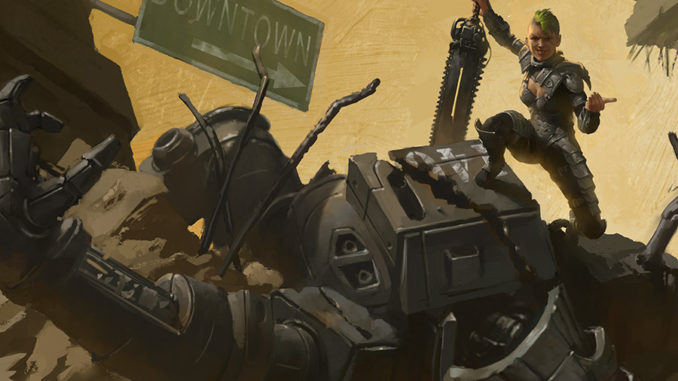
Recently, I reviewed the Savage Worlds core book. Today I take a look at a setting book that my group is considering for one-shots. Rifts®: The Tomorrow Legion Player’s Guide (TLPG) is the licensed Savage Worlds port of Palladium Books’ popular campaign setting and system. The setting book PDF costs US$15 and can be ordered at the above link or Drive Thru RPG. (No physical book available.)
TLPG’s Introduction explains how classic Palladium Rifts mechanics were re-done for the Savage Worlds version. It also includes a very limited account of the setting and history for those new to Rifts–just enough for someone unfamiliar, like me, to get the basic idea. Chapter 5 Rifts Earth goes into a little more depth on the history and politics–but not enough for me, although what little there was intrigued me. For example, I’d have liked to read all about the fallen magical city-state of Tolkeen–how and by whom/what it was founded, more about the war that was it’s downfall–not just that the Cyber-Knights’ schism was related and where the refugees fled to.
The best part of Chapter 5 for me was that I recognized the inspiration for Castle Refuge. Longtime Rifts fans may be interested to know there really are ruins of an abandoned castle in Lead Hill, a tiny, remote town in north Arkansas! (My adopted home state.) The Ozark Medieval Fortress, alas, was never completed and the attraction was closed and left to fall apart due to lack of funds.
The remaining TLPG chapters (1-4 and 6) cover the setting-specific information on character creation, gear, and mechanics. Chapter 1 Character Creation introduces the Iconic Frameworks that should enable original Rifts fans to make Savage Rifts PCs with the same feel. These Frameworks are similar to archetypes/careers you find in many RPGs. Each one gives you several free starting Ability and Skill dice upgrades, Edges, and gear. As part of creation, you also get rolls on tables (Hero’s Journey) that give you additional training, weapons, armor, gear, etc. Different Frameworks receive varying numbers of rolls, and are usually limited to certain tables.
There are Frameworks for all the Rifts types–Glitterboys, Juicers, assorted Psionics and mages, etc. The MARS (Mercenaries, Adventurers, Rogues and Scholars) Frameworks cover the not-so-heavy-hitter concepts, including a Build-Your-Own framework. To balance out the lower-power of these PCs, MARS Frameworks also allow rolls on a Fame and Glory table, along with the Hero’s Journey table rolls. Like the Savage Worlds core, there are many (setting specific) races plus extensive information for GMs creating their own new races.
This chapter also has a number of new Skills, Edges, and Hindrances for your Rifts PC. Some of the Edges are Iconic, that is, specific to one or a few Frameworks. The Skills, Edges, and Hindrances subsections each call out deletions and alterations of those in Savage Worlds Core.
From my more Rifts-savvy fellow players, I gather the gear in Chapter 2 has all/most of the goodies from the Palladium version. Plus other Savage Worlds setting books have gear that can be “imported,” since the titular Rifts make it easy to bring in PCs (and anyone or anything else) from practically any other genre/setting. This chapter also has much of the information on cybernetics and techno-wizards’ devices.
Chapter 3 Psionics and Magic covers most of the divergences from the base Savage World rules for these characters. Much of this chapter is descriptions and mechanics for new Rifts Powers. Most of the new powers are Mega Powers–because nothing is more Rifts-like than being able to deal or resist Mega effects. Chapter 3 ends with a discussion of the Ley Lines, which along with the Rifts, are responsible for so many of the changes on Rifts Earth.
Changes to Savage Worlds rules, as well as Rifts-specific rules, not covered in other chapters are discussed in Chapter 4 Setting Rules. The sixth and final chapter is The Hero’s Journey. While it starts with a page or so on Narrative Hooks, the majority of the chapter is the tables used in character creation, referenced in Chapter 2 and the individual Iconic Frameworks.
One of the most important purposes of a setting book is to help sell players on gaming in that setting. So how good a job does Rifts®: The Tomorrow Legion Player’s Guide do piquing a potential player’s interest? Pretty good, in my case. To be honest, I said, “Sure I’ll give Rifts a try,” only because everyone else in my usual group wanted to play it. But as I read through the book, and then made my PC, I found myself wanting to play because it looked like a cool world.
Linda Whitson
Latest posts by Linda Whitson (see all)
- Astral Projections – The Ripperdoc Is In - May 8, 2023
